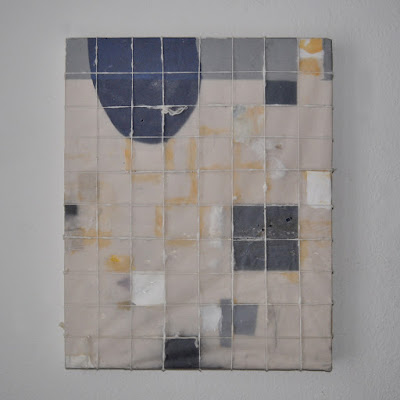MATT MANALO: "POCKET PAINTINGS"
POCKET PAINTINGS
October-November 2018
ET: I'm interested in some thoughts and/or preconceptions that you might
have had before starting this mini or tiny works project. You had mentioned,
for instance, that in your experience artists are encouraged to "go large."
In your example, what was the rationale for that advice?
MM: In considering tiny works, at first, I had to take a pause. I was
worried and excited at the same time. I knew I can pull it off but I wasn’t
sure what I was getting myself into. I agreed to the challenge because I always
enjoy doing things that will question my usual, tried and tested art practice.
I’m not a person who usually plans much to make something. Typically, I
solidify an idea in my head and I just go and make. Through the process of
making, I decide on what to add or remove.
I believe the
whole idea of “going large” was brought about by subliminal, visual languages
and through influence by art professors: When I was still in art school, my
professors always encouraged us to think of the “scale” of things. Whether it
may be the subject matter or different elements in a painting. At the same
time, we were also told to “go big” especially if it was in our nature to
make something medium-sized or worked small.
Another reason
would be whenever you would visit a museum, artists like Yves Klein, Robert
Motherwell, etc. mostly made large work. Larger than life masterpieces which
demanded your attention. Even with my last visit at the MET in New York, you’d
see a towering image of Mao Zedong by Andy Warhol or Chuck Close’s
self-portrait. Whoever visited that museum will never forget seeing those two
particular pieces.
The idea of
“going large” was a message to us young artists where “the bigger the better”
is the status quo. I did follow that advice. I understood the power of having
work in that scale. It almost felt like you had a powerful presence. It fed
your ego especially when you see people gathered around it and you compare a
person’s scale to your work. It was almost ridiculous to me. Almost cocky. I
never saw myself being one but the work gave me that feeling deep-inside.
ET: I'm tickled that the physical span of the exhibit is actually smaller than the exhibition notice itself! I've never seen this to be the case in the thousands of gallery visits I've experienced. What have you learned about scale from doing this project? What
surprised you most?
MM: I have learned that scale doesn’t shake my usual go-to’s with my art
practice that much but it surely required me to figure out which tools to use.
The process was still the same. It also reminds me of this viral video from a food channel where they were showing how to prepare tiny food.
I was surprised
at how time-consuming it is to make smaller work. I thought it was going to be
make the process faster but I was completely wrong.
ET: Initially, you were going to do just one work. That jumped to a
series of six works. Do you think the outcome would have been different if you
were doing one at a time versus knowing at the start that you would be doing as
much as six works?
MM: If I only did one piece, I would have felt incomplete. I think the
outcome would have been different because I wouldn’t check to see if I had
enough resources to make five more or how I would consider the composition of
the rest. Having to do all six at the same time helps me make the series more
cohesive in terms of materials and processes used.
ET: Please discuss the role of the strings in these Tiny Works. I think you
said that they came up during the process of making the works.
MM: I normally use the strings for another series of work where the
surface is wrapped with weathered tracing paper. It dawned on me, while making
the tiny series, that I could use the idea of the strings. I wanted to utilize
it to break the grid even more as well adding some tension to the soft
materials I am using. It also gives the piece another dimension.
Here are two examples of works with weathered tracing paper and string:
Here are two examples of works with weathered tracing paper and string:
Grid 01 (2018)
Grid 02 (2018)
ET: Please discuss your work in general and how the period of doing tiny
works might affect its direction.
MM: I create work as a form of an ongoing journal in navigating the society
as a Filipino/person of color. I continue to reconcile with my old life and my
new life here in the United States. Because of this, I was looking for a
tangible outlet to express my feelings, identity, memories, and newfound
experiences while constantly redefining “Home” and identity.
My work
represents an abstract image of a specific place or memory from either back
home or from my environment. I incorporate repetitive marks, shapes, collage,
stamped images, and text on my work. They signify the amount of “to and fro”
with flashbacks or conversations I have when making a piece.
Gaining
experience and knowledge with making tiny work has opened my eyes to more
possibilities in pushing my ideas further in terms of scale, resourcefulness,
materials, and visual language.
ET: Thank you, Matt! Thanks for your openness to making tiny works and I am
truly appreciative of how their scale did not at all dilute the complexity of
your works. Salamat!
Formation 1
Formation 2
Formation 3
Formation 4
Formation 5
Formation 6
*
















Comments
Post a Comment